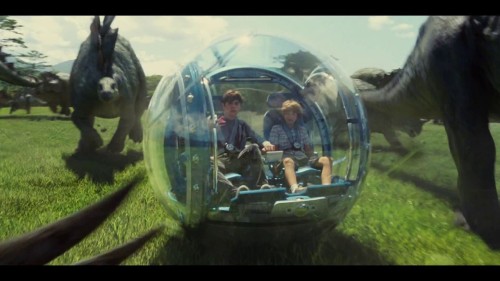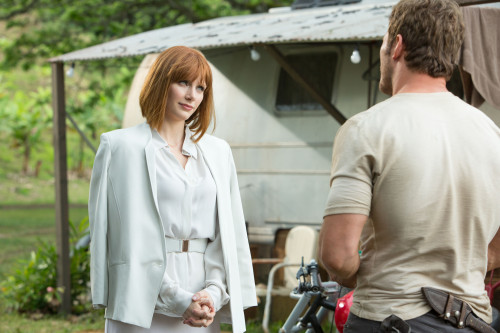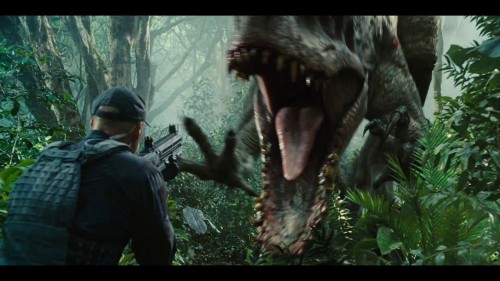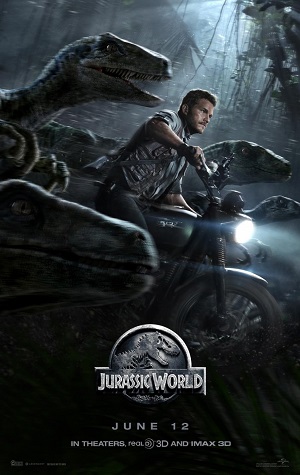First of all, spoiler alert.
The Jurassic Park franchise has historically been a major draw. The original 1993 film was the largest grossing movie of all time until Titanic came along four years later. The second film, though largely sub-par when compared with the first, held the record for the largest opening weekend until 2001, when some movie about a little boy wizard came along and took over. These were original event pictures, massive draws that were required summer viewing for the young millennial generation. Dinosaurs are cool, and people love seeing dinosaurs.
That seems to be holding true for Jurassic World, the latest entry in the series. Originally forecast to make something in the vicinity of $125 million in its opening weekend, the movie made nearly that on Friday alone. Early reports have the movie taking in an opening weekend haul of $204 million, which puts it at the third best opening of all time. Meanwhile, across the world, the film took in a staggering $511 million dollars, an all time world record. People still love their dinosaurs.
 This is commented on fairly early in the film. The two token children (Ty Simpkins and Nick Robinson), while putzing around the visitor’s area, come across a small petting zoo. Here, children can get up close and personal with miniature versions of the park’s larger herbivores. Kids can ride around on baby triceratops – one of countless homages to the original films (more on that later). In a relatively affecting instance, a little girl throws her arms around the neck of a dopey baby apatosaur, embracing the childlike wonder and awe many of us have felt ever since that first brachiosaur walked across the plains in the first movie.
This is commented on fairly early in the film. The two token children (Ty Simpkins and Nick Robinson), while putzing around the visitor’s area, come across a small petting zoo. Here, children can get up close and personal with miniature versions of the park’s larger herbivores. Kids can ride around on baby triceratops – one of countless homages to the original films (more on that later). In a relatively affecting instance, a little girl throws her arms around the neck of a dopey baby apatosaur, embracing the childlike wonder and awe many of us have felt ever since that first brachiosaur walked across the plains in the first movie.
Unfortunately, the rest of the movie fails to capture that awe. Jurassic World is a largely empty summer blockbuster. The plot is fairly rote – after a dozen years, the monolithic corporation that ran the first Jurassic Park has reopened a theme park on the original island, turning it into the latest destination resort. For what is probably a dramatically hefty price, tourists can stay at the Jurassic Park Hilton, stroll down a main street complete with a steakhouse, Starbucks, and Oakley’s sunglasses outlet, play in the Creation Center (sponsored by Samsung), and ride around in open aired busses and whirling gyrospheres, getting up close and personal with creatures from another time.
At the same time, the bottom line rules the day. Attendance rates are dropping, so the company asks for a new attraction to be created, a genetic hybrid combining the DNA of a T-Rex, cuttlefish, tree-frogs, and raptors – the mandate is to create an animal that will be the most dangerous creation to ever stalk the planet. Sure, that seems like a good idea, given what happened in the first movie. What could go wrong?
Inevitably, the creature escapes in a fairly contrived scene involving the only exit to the hybrid’s cage being a giant gate as opposed to a human sized access tunnel – this movie isn’t exactly shy about ignoring gaping loopholes in its plot. What sets it apart from similar films like Prometheus is that Jurassic World isn’t pretending to be a grand philosophical statement, so the plot holes don’t undermine the ostensible intelligence of the film. Nevertheless, these plot holes are large enough to drive a bus through.
That’s about all of the plot that matters here – dinosaur escapes, dinosaur goes on a killing spree, and the human characters are forced to resort to desperate measures to save the park’s guests. It’s a story that has worked for almost a hundred years in cinema, dating back to The Lost World in 1925. For the most part, it works here. The underlying knowledge that the hybrid is on the loose propels the film forward, and we as audience members cling on for dear life as the film rockets over the park.
 There’s two interesting ideas that get discussed in the film: the first is the aforementioned declining interest in the public at the dinosaurs of the park. It’s reflected in the gonzo advertising for a movie about dinosaurs coming to life. The public gets tired of ideas quickly, unless the wow factor is amplified (see: Avengers: Age of Ultron or any other massive franchise movie, where bigger is better). The movie is certainly self-aware of this, upping the spectacle by bringing in bigger and badder dinos such as the aquatic mosasaur and a horde of flying pteranodons and dimorphodons that attack a streetful of patrons in the movie’s best realized action scene.
There’s two interesting ideas that get discussed in the film: the first is the aforementioned declining interest in the public at the dinosaurs of the park. It’s reflected in the gonzo advertising for a movie about dinosaurs coming to life. The public gets tired of ideas quickly, unless the wow factor is amplified (see: Avengers: Age of Ultron or any other massive franchise movie, where bigger is better). The movie is certainly self-aware of this, upping the spectacle by bringing in bigger and badder dinos such as the aquatic mosasaur and a horde of flying pteranodons and dimorphodons that attack a streetful of patrons in the movie’s best realized action scene.
The second idea involves a shady military contractor (Vincent D’onofrio) who wants to use the dinosaurs of the park as weapons of war, citing that trained velociraptors could be dropped into cave combat situations and root out enemies far more efficiently than any drone or soldier could do. It’s an idea that gets tossed into play when the security officials release a pack of raptors to chase down the hybrid. (Hey, another good idea, certainly nothing can go wrong from letting raptors loose, right?)
The unfortunate truth is that the ideas in play don’t really get the conversation that director Colin Trevorrow desires because none of the humans in the movie are anything more than stock types. Bryce Dallas Howard’s park head is the worst of these, a Type-A shrew written from a horribly sexist perspective. Initially cold and alienating, it takes Chris Pratt’s he-man to show her how to lighten up and be more of a human/woman. That’s bad enough, but Pratt’s Owen Grady isn’t anything more. Guardians of the Galaxy showed that Pratt is a witty, charming lead, but that’s wasted here. Grady is nothing more than a poor man’s Indiana Jones, a raptor trainer with barely any lines that showcase character. (He was a Navy Seal at one point…and that’s about it.) Even the stock characters are bland and boring – Jake Johnson’s computer tech seems to have the most personality, which is unfortunate because his character’s purpose is ill-defined and ultimately irrelevant.
The lack of characters to care about makes for a wickedly dull climax, because we simply don’t care enough about these anonymous humans enough to worry that they’re in any danger. This isn’t helped by the fact that the dinosaurs are largely CGI. In previous films, practical dinosaurs added a sense of danger. Here, we’re watching actors react to green screens. There’s never a sense that any of this will end poorly for anybody involved. It’s interesting to watch a small backlash against CGI come to fruition against this film, if only because the first Jurassic Park was a milestone in the use of CGI to create fictitious dinosaurs. Life is coming full circle.
 The movie is not without merit – the dinosaurs do look amazing, and are definite high points of the film. In particular, the raptor pack has more character than do most of the humans training them/running away from them. A grand final shot after the climax shows the T-Rex (one of two returning characters from the first film!) and the raptor named Blue communicating following the death of the hybrid. There’s almost a sense of mutual respect and admiration between the two. (Jurassic World 2 will actually be a straight up remake of Tommy Boy featuring these two dinos, if the filmmakers know what’s good for them.) The hybrid is legitimately realized, and the pterosaur attack is a definite high point, as mentioned before. (Look for the tourist running away with two margaritas in hand – definitely a high point, like I said.)
The movie is not without merit – the dinosaurs do look amazing, and are definite high points of the film. In particular, the raptor pack has more character than do most of the humans training them/running away from them. A grand final shot after the climax shows the T-Rex (one of two returning characters from the first film!) and the raptor named Blue communicating following the death of the hybrid. There’s almost a sense of mutual respect and admiration between the two. (Jurassic World 2 will actually be a straight up remake of Tommy Boy featuring these two dinos, if the filmmakers know what’s good for them.) The hybrid is legitimately realized, and the pterosaur attack is a definite high point, as mentioned before. (Look for the tourist running away with two margaritas in hand – definitely a high point, like I said.)
What ultimately makes the movie worthwhile is its self-awareness. It realizes that the theme of overkill in the name of entertainment is what actually brought it to the screen in such a shape, and it embraces that. It knows what it is, and doesn’t shy away from fan service that borders on nostalgic overkill. References to the first movies abound. A familiar character makes an appearance on book jackets. The spitter makes a wonderful cameo appearance. At one point, the two kids walk through the abandoned visitor center from the first film, finding lost T-Rex teeth and shreds of the “When Dinosaurs Ruled the Earth” banner that memorably plummeted to earth. Billions of these moments (an overstatement, sure, but then again, did you see this movie?) are sprinkled throughout the movie, and serve as almost gratuitous fan service – but it works. This is an attempted return to the glory days of Jurassic Park, a vision of what could have been.
Yeah, it’s fan service, but clearly we are responding to this. These movies are the backbone of the childhood of an entire generation, and seeing a sleek monorail crash through the iconic gates of the first film as the sweeping theme rings out is enough to send a shiver through the spine of any human being of a certain age. The movie may be a hybrid of its own creation, like its albino-skinned villain, but it’s enough to call back memories to a time when dinosaurs ruled the earth. At the very least, there are far worse ways to spend your summer dollars at the box office.
Then again, there are better ways. Go see Mad Max: Fury Road or Spy before you check this out for the third time. Given the box office returns of the weekend, this franchise clearly isn’t going anywhere anytime soon.







Just found out that tourist running away with the two margaritas is Jimmy Buffett…because of course.